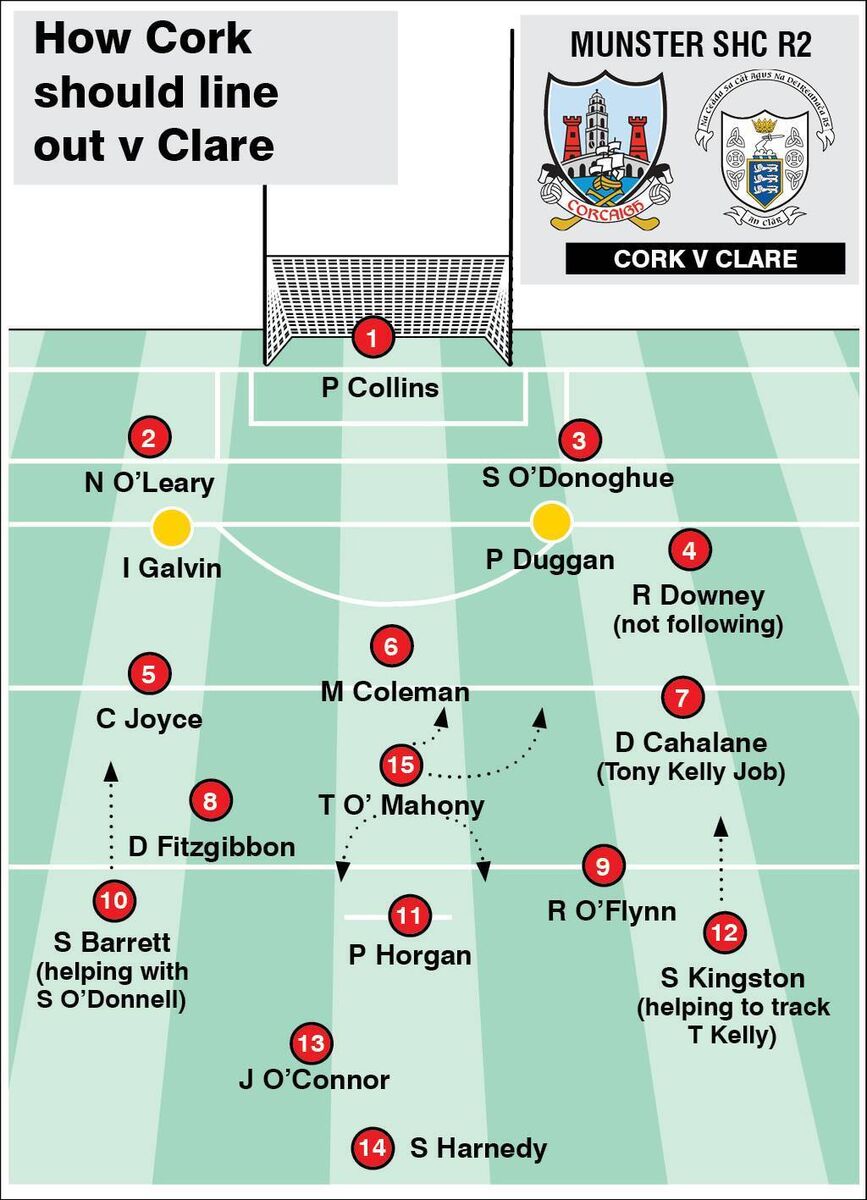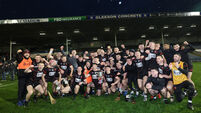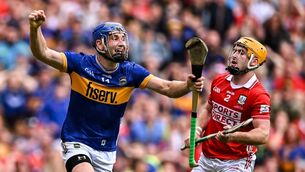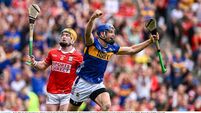Derek McGrath: Cork must block out the noise and do what they know is right

Sharpening his eyes: Cork manager Kieran Kingston watches his charges closely earlier this spring. Pic: Eóin Noonan/Sportsfile
Reading my then 10-year-old son Fionn’s school books doesn’t normally provide me with moments of clarity, but a passage on Rosa Parks, the famous civil rights activist, delivered a crucible moment some years ago.
“I have learned,” she said, “that when one's mind is made up, this diminishes fear; knowing what must be done does away with fear”.
Following the pummelling Waterford received from Tipperary in the 2016 Munster Final, the self-reflection process began in earnest. Doubts surface and lodge and the strength and unity of the group is paramount.
We were exposed to a very lazy public narrative. Flooding the middle third with up to four of our forwards and midfielders, allowing Tadgh de Búrca to man the D, is par for the course now, but the language years ago was far different.
Many times I met supporters saying: “Would you ever let the team out 15 v 15, man on man?”.
Firstly, restricting the team is not your job. Instead, management involves a consultative vision, an assessment of your current trajectory and the players at your disposal. My counter-argument was, and remains, that those systems of play, that discipline of structure, allows freedom to express and create.
The irony now is that the most vocal critics, particularly from Tipperary and Cork, are coming to the belated conclusion that we can still have man on man battles within the flexibility of the modern game.
The Cork brains trust of Kingston, O’Sullivan, Furlong, Mulcahy and O’Grady will have tried their best to ignore the outside world, but this can be difficult for a homegrown management team. Cries to “let the ball in” and “go forward” will have tested their steadfast principles.
Balancing what they witness each night at training with current confidence levels in the group, while taking into account the possible permeation of their inner circle by the cries from outside is difficult. Gary Keegan will have played a huge role in ensuring that the processes trusted prior to the Limerick game have been reassessed and realigned to meet their current needs.
This may well involve doubling down on their values. It may have involved a “vulnerability” session where players openly critique each other’s current form, emotions and contribution to the cause. Such meetings can be extremely open, emotional and potentially damaging and need to be facilitated with a high degree of skill. They can also be powerful, emotive catalysts for passionate commitment and performances.
I disagree strongly with the argument that the Cork players are ‘bottlers’, ‘afraid to take a belt’, ‘shapers’ etc. Consistently I have argued that no inter-county player is ‘soft’. Could they have run harder, tackled more ferociously, been more organised defensively, and combined better their speed of foot with speed of delivery? Yes. But I believe this Cork team and management would have discussed and simulated at length the need to merge their undoubted skill and speed with a vicious savagery ahead of the Limerick challenge.
All top-class performers are willing to step into discomfort, attack the friction of adversity and go on the road less travelled, a road Al Pacino in calls “a path that’s made of principle that leads to character”.
Kieran and his players, with the help of Keegan, will have looked at adapting their perspectives, concentrating on each moment as opposed to each ball.
Practically, the Cork players and management team, to ensure presence in the now, may well have looked at the work of Dr Andrew Huberman who often talks about “eye movement desensitisation and reprocessing”, the art of walking forward whilst moving your eyes laterally left to right, helping to quieten negative emotions.
We often see top players with their “eyes wide open”, clearly engaging in this triggered performance enhancer.
Simon Sinek’s came to mind when thinking about what Cork perhaps need next. Sinek says: “We don’t just trust people to obey the rules, we also trust that they know when to break them.”
My feeling is that this management group and players, led by emerging leaders in Coleman, Joyce, Kingston and Fitzgibbon, will stop at nothing to improve and help Cork. This has not presented itself yet and may need a combined fusion of properly channelled hurt and anger with some imaginative creativity.
It’s been two long weeks for the Cork players, management and their families and the human aspect associated with under-performance should never be overlooked. I witnessed first-hand Kevin Moran diligently and wholeheartedly teach his classes many Mondays after comprehensive defeats with Waterford and I have no doubt that similar traits are to be found within these Cork players.
Against Limerick, Cork would have hoped to mix up their gameplan, running it through the lines when it’s on, but also mixing this with angled deliveries to the inside line. Defensively, I am confident they would have placed detailed concentration on tagging Cian Lynch and not leaving themselves exposed at the back. When the opposite materialises, the populist points to lack of planning.
So what might they consider?

Cork will be aware that Clare, like most teams. set up with two inside. Last week this was Ian Galvin and Peter Duggan with Robin Mounsey doing his Peter Casey impression 50 yards from goal.
To ensure clarity for the players, Cork may have Sean O’Donoghue or Damien Cahalane picking Duggan and Niall O’Leary picking Galvin. To add another layer of protection, Cork may consider Robert Downey as the one in the full back line who doesn’t follow his man out. Questionable pace but unquestionable hands and hurling brain can then be used more appropriately. Downey may locate himself on the left-hand side of the defence not following his roaming corner forward and instead handing him over to the “pack” and becoming an out-ball for Patrick Collins.
Clarity for Damien Cahalane would see him tagging and hounding Tony Kelly as per the Seamus Kennedy maxim last Sunday but with one distinct change. If Kelly goes past 70 yards there will be a clear handover to new ‘third midfielder” Tim O’Mahony.
The “talk” around Cork's 3 and 6 has been overhyped for me. Perhaps for 10-minute powerplays or on resets at puckouts it’s important, but are there many teams setting up with three inside the 21 anymore?
For Mark Coleman or Ciarán Joyce to play as a sweeping 6, as per all sixes, the wall in front of either has to be more savage. One or either can give tuck-in protection from wing back by not following his man 100 yards from the goal, mimicking Tipperary’s gullibility.
It’s also up to Collins and the full backs to get the creative backs on the ball more. Cork must set the terms of engagement and I would go with a three-man midfield of Darragh Fitzgibbon, Tim O’Mahony and Robbie O’Flynn.
A little bit strange for some but if the midfield three are supported by a half-forward line of Barrett, Horgan and Kingston, with an inside two of Harnedy and Jack O'Connor, a strong argument can be made that with the exception of Conor Lehane, Cork have their 15 best hurlers on the pitch.
The difference then comes with Horgan’s positioning at 11, O Mahony’s location right in the middle of Fitzgibbon and O’Flynn and Jack O’Connor’s return to the team. Added difference may come from the impact of Lehane, Cahalane and perhaps Mark Keane from the bench.
The art of individual man-marking coexisting with collective defending will have been addressed. Coleman or Joyce must feel confident knowing that when they protect the D the wall of midfielders and half forwards are racing back to support and tackle and O’Mahony in particular is taking up the Clare 11.
Detail is key. Cork must plan for scenarios such as Kelly taking up residence in the full-forward line or O'Donnell starting inside there. They must work out, if playing an extra midfielder, how you can still fill the six spots on Eibhear Quilligan’s puckout. This involves repetitive scenario-based coaching. Horgan may temporarily locate himself at 14 while O’Mahony comes to 11, tempting the long puckout before reverting to your proactive shape.
Cork people may well say: “No Tommy O'Connell, no Mark Keane”. My feeling is that project work must be replaced by the immediate term focus on tweaking and reconfiguring. Perhaps Cork don’t have the time to do otherwise.
From Collins to O’Gara to Keane, Cork people haven’t been found wanting when it comes to improvisation or change.
The much vaunted “bunch and break” puckout strategy was rolled out by JBM, Cusack and co. There was Newtown’s O’Connor-fuelled possession game and O Grady’s similar model ensued. Now it’s time for the next version.
No team can innovate without the risk of failure. Creativity can at times leave you vulnerable. The courage to confront and embrace those possibilities and weaknesses is where Cork can find their way again. To do so they'll need to adhere to Mark Twain’s warning: “You can’t depend on your eyes when your imagination is out of focus.”







